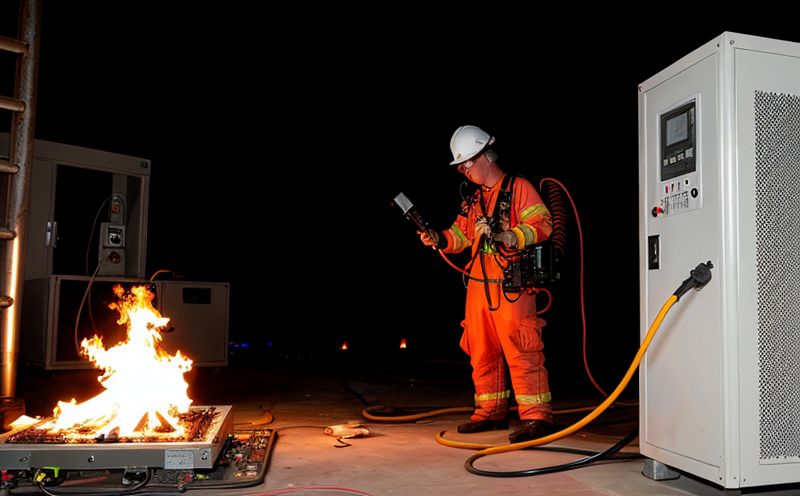ISO 1210 Flammability Testing of Electrical Enclosures
The ISO 1210 flammability testing is a critical standard used to evaluate the resistance of electrical enclosures to ignition and flame spread. This test ensures that products meet stringent safety standards, particularly in environments where high temperatures, sparks, or flames are present.
Electrical equipment can be exposed to numerous fire hazards in various sectors such as industrial manufacturing, transportation, and construction. These hazards include overheating components, electrical arcing, and exposure to external sources of ignition. To prevent potential fires, manufacturers must ensure that their products comply with the appropriate standards, including ISO 1210.
Our laboratory adheres strictly to the guidelines set forth in ISO 1210 for flammability testing. This standard provides a framework for assessing the performance of electrical enclosures under controlled burning conditions. The test helps manufacturers and quality assurance teams identify potential weaknesses in their designs, ensuring that products can withstand fire hazards without contributing further to the spread of flames.
The process involves subjecting an electrical enclosure to a series of flame impingements according to specified procedures. The specimen is placed on a standard support frame within a test chamber, which maintains a specific temperature and atmosphere. Once ignited, the duration and intensity of the flame are measured, along with any subsequent spreading behavior.
The results of this testing allow manufacturers to assess how their product will perform in real-world scenarios where fire risks exist. By identifying areas for improvement early in the design phase, companies can enhance the safety features of their products, thereby reducing the likelihood of accidents and protecting end-users from potential hazards.
Our laboratory is equipped with state-of-the-art facilities to conduct this testing accurately and consistently. Our team of experts ensures that every specimen undergoes rigorous scrutiny, providing reliable data that supports informed decision-making processes within organizations.
| Key Parameters | Description |
|---|---|
| Test Specimen | The electrical enclosure to be tested, following standard dimensions provided in ISO 1210. |
| Flame Impingement | A series of controlled burns applied to the specimen, lasting for specific durations as per the standard. |
| Temperature Control | The test chamber maintains a constant temperature throughout the testing process, ensuring consistent results. |
| Data Collection | Measurements include flame propagation rates and time to extinguish after each impingement. |
To summarize, ISO 1210 flammability testing plays a vital role in safeguarding against fires caused by electrical equipment. By complying with this standard, manufacturers demonstrate their commitment to product safety and regulatory compliance. Our laboratory offers comprehensive support throughout the testing process, offering valuable insights that contribute positively towards enhancing fire resistance capabilities.
Scope and Methodology
The scope of ISO 1210 flammability testing encompasses various aspects aimed at assessing the ignition resistance properties of electrical enclosures. This includes evaluating how well these components can withstand exposure to flames without catching fire themselves or contributing significantly to the spread of flames.
- Testing is conducted on electrical enclosures that are intended for use in potentially hazardous locations where sparks, high temperatures, or direct flame contact may occur.
- The test involves exposing specimens to controlled burns under specified conditions, measuring both ignition behavior and flame propagation rates.
- Data collected during testing helps determine if the product meets the required safety thresholds outlined by ISO 1210 standards.
Our laboratory strictly follows these guidelines when performing ISO 1210 tests. We ensure accurate data collection through precise measurement techniques, providing reliable results that guide informed decisions regarding design improvements and material selection for enhanced fire resistance performance.
Why Choose This Test
The ISO 1210 flammability test is essential for ensuring the safety of electrical equipment in hazardous environments. By choosing this test, manufacturers can significantly reduce the risk of fires caused by their products. The benefits extend beyond mere compliance; they also contribute to improved product reliability and user confidence.
One key advantage is the ability to identify potential weaknesses early on in the design process. Through rigorous testing, engineers gain valuable insight into which materials or configurations are most effective at preventing ignition and minimizing flame spread. This knowledge enables them to make informed decisions that ultimately result in safer products.
In addition to enhancing product safety, adhering to ISO 1210 standards can also provide significant competitive advantages. Customers increasingly demand safer electrical equipment, especially when purchasing items for use in potentially dangerous areas like oil refineries or mining operations. Companies that demonstrate their commitment to quality by meeting these high standards often find themselves preferred over competitors who do not.
Moreover, ISO 1210 compliance helps protect manufacturers from liability risks associated with product failures leading to fires. Demonstrating due diligence in ensuring product safety can shield companies from costly legal battles and negative publicity following an incident involving their equipment.





